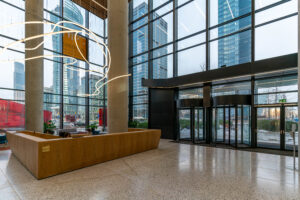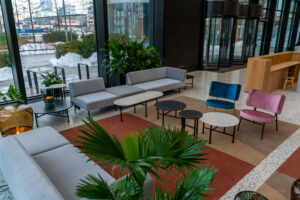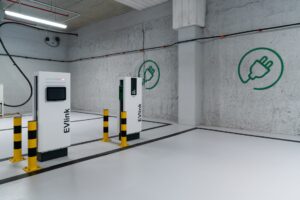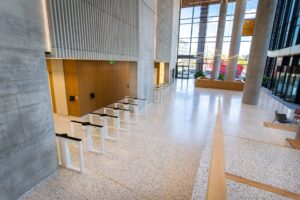
Smart buildings are not a completely new concept. However, these days the quality of services and functionalities that businesses expect from their office or business space has increased. Of course, keeping things as sustainable as possible, energy-efficient, and safe is a must, and according to HID, there is scope for thinking smarter and bigger.
We spoke to Jaroslav Barton, HID’s product marketing director for physical access control, to take his views on the future of Smart Buildings.
Last year, for the first time, HID attended the Smart Buildings Show, showing its interest in expanding into areas beyond just the security sector.
“In recent years, we have seen an evolution in the Smart building environment,” noted Barton, “Installers today look to security solutions not as a stand-alone but as an integral part of a more holistic approach to the smart building concept.
“Buildings used for business purposes must include attractive features to enhance the user experience and add value to those renting the space. Identifying areas where a building might be weaker, whether in terms of sustainability, energy efficiency, or user experience, is key for security experts who can offer a holistic solution to their customers, integrating access control security and building automation.”
As a result of adopting a smart building approach, occupants and the whole company can be more productive, and the environmental impact can be diminished.
We have heard about smart homes in the residential market for a while. Family lodgings are easier to coordinate and optimise with automation features. However, a building where hundreds of people will come and go requires specific expertise.
Before, there were areas of a security plan for a building that worked together and others that wouldn’t – or wouldn’t have to be integrated. Now, to future-proof projects, the full functionality of the building needs to be considered as a whole living and breathing entity.
More data requests
We asked Barton why now, what has changed in the Smart Buildings realm?
 “These days, building managers need more data on what’s happening around them,” he says. “This data should be readily available to analyse and used to improve the working of the smart building, making its operations more secure and safe.”
“These days, building managers need more data on what’s happening around them,” he says. “This data should be readily available to analyse and used to improve the working of the smart building, making its operations more secure and safe.”
Historically, people used cards to access buildings; now, digital credentials are being used. There is a transition from plastic and the use of RFID to mobile devices and wearables in many vertical sectors. Digital data about users can be safely stored in the cloud and be easily accessed in situ or remotely, granting access permissions for residents and visitors.
HID uses its HID Origo cloud platform for physical access control. The open platform enables technology partners to build integrated access control solutions through the cloud.
As a scalable and secure infrastructure, HID Origo provides top-notch service. Aside from delivering guaranteed performance, this framework offers higher data and privacy protection than traditional on-premise solutions.
Using mobile and wearable devices means a new layer of data is available to building managers. This data can be integrated with third-party systems around building automation beyond access security. It will influence how a building is managed.
Barton explains, “For example, if someone enters the building using their mobile phone and then takes the lift, the system can identify where they need to go. If they work on the 6th floor, they can be taken directly there without needing to press any button. Additionally, anyone not allowed in certain areas of the building will not have the choice to access it.”
The environmental benefits of using the access data are clear. As the building knows when someone is coming to work in their office, lights, heating, or aircon can be readily switched on. Conversely, the building will also know if a room is vacant, and it will switch everything off, saving energy.
“At HID, we have seen interesting developments in how office buildings are being used, especially after the pandemic,” says Barton and adds, “The pandemic has brought hybrid working or remote working and more work flexibility, which needs to be catered for. This makes managing an office building more complex, as the number of people present at any point can vary vastly daily.”
Using identity positioning within a building

The HID mobile solution can also be expanded beyond entrance and exit doors to provide indoor identity positioning. Anonymised data about employees and how they move inside the building can be collected to ascertain what areas are in most use, which are dead areas, and how people move inside the building regarding location and time.
“People’s privacy is of utmost importance,” clarifies Barton, “this is not about checking how long a particular person takes to make a coffee.”
Heat maps and occupancy data allow companies and building managers to understand how the building is being used during the week and month and optimise the space needed for its operations.
A good example is a project HID has been involved with in Poland, where a building contractor has one tenant. This company employs 400 but only has 100 desks available at any time. The car parking slots are also limited, but it does offer 350 bicycle spaces.
Using HID access control solution and HID’s technology partner, Hellopark, the company avoids renting four floors and 400 desks. Instead, employees can book their parking and desk spaces through the Hellopark app. Meeting rooms and other needs are also catered for within the application.

“This is just one of our technology partners,’ points out Barton. “The applications can be varied based on what the business owners want to offer and the tenants’ needs. The information that can be made available is limitless, from canteen menus and public transport timetables to company meetings, special events, and more; all can be distributed to reach the right person at the right time.”
Legacy systems
The first step when looking at a project is to assess the smart technology currently in use within the building. By doing so, installers can determine whether better use of technology can be made and if new technology can be introduced to complement the existing smart solutions. However, there is no need to change everything.
HID provides a platform of trusted identities that its partners can integrate into their solutions.
Barton explains, “We provide an API to connect provisioning and management of digital credentials with security or building management systems. Software Development Kit (SDK) enables customers to integrate HID Mobile Access into their company or building’s smart device apps. “
“We do see lots of legacy systems in the market. Legacy systems don’t need to be completely replaced. By upgrading or replacing the access control readers , you can potentially prolong the life span of the legacy systems.”
HID uses Open Supervised Device Protocol (OSDP), which provides an open and bi-directional encrypted communication. The OSDP protocol is implemented over a multi-dropped RS485 hardware bus, enabling not only access control data transfer but also to control reader behaviour, including LED and beeper indicators.
Are there risks of hacking for users?
The short answer is ‘No’. HID uses third-party penetration testing to ensure that all data is securely used and shared.
Barton says, “As providers of trusted Identities, security and privacy protection is of utmost importance for HID. Independent parties check that the solution and apps are safe to use. We never collect any personal information.
“The employee badge in Apple wallet is a further expansion of the capabilities of HID Mobile Access, and it’s done in close cooperation with Apple. Storing mobile access credentials in the Apple wallet is as secure as saving your credit card on your phone, which most people do these days.”
Why aren’t all buildings smart yet?
 According to Barton, educating the market about the benefits and changing people’s perspectives is a matter of educating the market.
According to Barton, educating the market about the benefits and changing people’s perspectives is a matter of educating the market.
“Some companies need to change their mindset to go from plastic cards to mobile phones,’ says Barton. “Forward-looking companies might find it natural to go mobile immediately. Others will doubt and think they don’t need to change yet, a system already in place.”
“Many organisations start by including hybrid solutions to ease people into the new habit.”
Barton shared that smart building integration with security solutions is unrelated to specific vertical markets. There are some exceptions, such as organisations that might not allow mobile phones on premises to keep the company’s processes private or for hygiene concerns. But most enterprises will see no obstacle and embrace it as soon as they know more about its benefits.
The top tip for installers and integrators is to get a clear picture of how the building is being used to ascertain what functionalities might be available to maximise the return on investment and help achieve the client’s goals.







